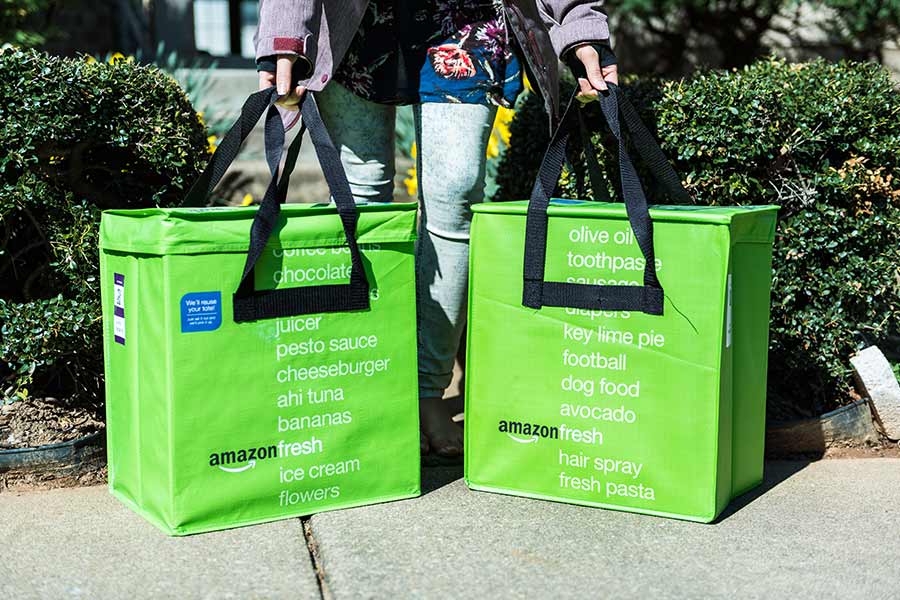Resources - Blog
How Sellers Can Take Advantage of Amazon Fresh’s Growth During COVID-19

Stay on top of the latest e-commerce and marketplace trends.
The COVID-19 pandemic shifted many consumer shopping trends over the past few months, especially how people buy food. As social distancing quickly became the new norm, it has generated an unprecedented demand for buying groceries online.
Amazon has been trying to offer a grocery delivery solution for more than a decade. It launched Amazon Fresh in Seattle in 2007 and has consistently been expanding to other major cities across the U.S., and to date, select cities in Germany.
Ten years later, in 2017, Amazon acquired Whole Foods Market for $13.7 billion, further showing its desire to dominate the grocery industry and become the leader in meeting this growing customer demand.
As consumer shopping habits continue to change during the current pandemic and beyond, this presents an excellent opportunity for Amazon sellers and CPG brands to take advantage of Amazon’s extraordinary growth in this area.
What Does Amazon Fresh Offer Customers?
Amazon Fresh and Whole Foods Market deliveries are available for Prime members by invitation only. Customers can sign up for an invitation, but if they are not already a Prime member, they will need to become one first. Members can purchase thousands of items, including produce, meat, seafood, snacks, and household essentials through Amazon Fresh.
On Oct. 29, 2019, Amazon dropped its $14.99 monthly fee and made Amazon Fresh free for Prime members in the U.S. Prime members also get free delivery when ordering from Whole Foods. Amazon combined the ordering sites for Amazon Fresh and Whole Foods Market, making it easier for customers to place their orders, which can also be done through Alexa voice assistant. Free, two-hour grocery deliveries are another valuable benefit that Amazon Fresh offers.
The Growth of Online Grocery
Amazon is certainly not the first to offer grocery delivery service, as many brick-and-mortar grocers have been delivering to their customers for years. Online grocery businesses, like Instacart, Peapod, and Fresh Direct, are the major competitors to Amazon Fresh.
Groceries are an estimated $678 billion market in the U.S. Research firm eMarketer predicted that food and beverage online sales would grow 23.4% to more than $32 billion this year, making it the fastest-growing e-commerce category. What is interesting is that this projection came before the COVID-19 crisis.
During the COVID-19 pandemic, even more people started ordering their groceries online, leading to a permanent food buying shift and a massive revenue boost for Amazon.
According to an RBC Capital Markets survey on online grocery trends, it concluded that Amazon Fresh could produce $70 billion in gross merchandise volume by 2023, triple what it produced in 2019. This means that grocery would make up a significant portion of Amazon’s total revenue.
The survey was conducted with 1,500 respondents in early-April 2020, during the height of stay-at-home orders around the country. It found that 42% of respondents purchase groceries online at least once a week, which is a 22% increase over 2018. It also discovered that Amazon is the most frequent destination for online groceries with 60%, compared to 47% for Walmart.
More than half of the respondents stated that COVID-19 is “leading them to permanently boost their willingness to buy groceries online.” Those who have not bought groceries online, 41% (up from 19% in 2018) said they intend to do so in the coming months.
Meeting the COVID-19 Online Grocery Demand
In early-April, The New York Times reported that Amazon grocery orders were 50 times higher than usual. This led to struggles with fulfillment and delivery. Customers were experiencing long delays and there were no open delivery windows for weeks. Due to the surging demand, the company was forced to create a waitlist for new Amazon Fresh member sign-ups.
To meet the skyrocketing demand, Amazon announced in mid-April that it expanded Whole Foods Market grocery pick up from about 80 stores to more than 150, ramped up hiring, and adjusted store hours at select Whole Foods Market locations to focus exclusively on online grocery order fulfillment. Amazon also opened its Woodland Hills, Calif. location as a temporary online-only store, to focus solely on fulfilling grocery delivery orders.
Amazon also announced that they would be releasing delivery windows throughout the day, making it easier for customers to see when the next window is available by including it on the Amazon Fresh and Whole Foods Market homepages.
It seems that these changes have worked. An Amazon spokesperson reported that it increased the number of grocery orders it can fulfill by 60%. Although finding open delivery times can still be challenging, Amazon’s goal is to increase capacity to deliver to more customers and also its capacity to welcome new Amazon Fresh shoppers.
How Amazon Sellers Can Capitalize on This Growth
With COVID-19 still impacting the economy and how we shop, changes in consumer behavior are expected to outlast the pandemic and become permanent. The most profound change is happening in online grocery. It is the fastest-growing and least penetrated e-commerce category, which presents profitable selling opportunities for food suppliers, vendors, and CPG/food and beverage brands.
If you are already selling under the grocery category, now is the time to invest in product expansion and marketing. If you are not selling in the grocery category, this area presents a remarkable business opportunity for product development. You can learn more about Amazon’s policies and requirements for selling grocery items here.
Learn what Feedvisor can do for your business.
When you partner with Feedvisor, you automatically receive access to our true, AI-driven technology and hands-on team of e-commerce experts. Contact one of our team members today to learn more about our end-to-end solution for brands and large sellers on Amazon, Walmart, and e-marketplaces.




